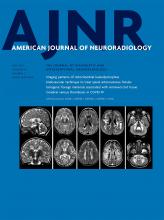We read with great interest the literature review by Gulko et al1 that included 22 articles reporting the MR imaging brain findings of 126 patients with coronavirus disease 2019 (COVID 19). We agree with the authors that the most frequent diagnosis on MR imaging is acute and subacute infarct, which was reported in 32 of 126 patients. However, because of the different imaging techniques used in the original articles, the frequency of leptomeningeal involvement may be underestimated.
We observed great differences in the reported frequency of leptomeningeal enhancement in the articles included in this review. Helms et al2 reported enhancement in leptomeningeal spaces in 8 patients (68%). On the other hand, leptomeningeal enhancement was absent (0%) in several other studies with similar patient samples.1 This discrepancy may be attributed to the different imaging techniques used to evaluate leptomeningeal involvement. The contrast-enhanced 3D-FLAIR sequence was used by Helms et al,2 while only conventional T1WI postcontrast sequences were performed in several other studies.
In our practice, 3D-FLAIR sequences or 3D T1 black-blood imaging or both are used to clearly demonstrate leptomeningeal enhancement. Leptomeningeal involvement seems to be a relatively common manifestation of CNS involvement in patients with COVID-19. Herein, we present a 68-year-old woman with COVID-19 who underwent brain MR imaging 2 weeks after extubation, because of confusion and muscle weakness in her limbs. Turbo spin-echo 3D-T1 black-blood and 3D-FLAIR sequences postcontrast administration revealed leptomeningeal enhancement in the left angular gyrus (Fig 1) and on both sides of the right parieto-occipital sulcus (Fig 2). Enhancement was not prominent on conventional (turbo-field echo) 3D-T1 images.
Sagittal 3D turbo spin-echo black-blood T1-weighted (A) and 3D-FLAIR (B) images, both postcontrast administration, reveal leptomeningeal enhancement in the left angular gyrus (arrows, A and B). Enhancement is not prominent on T1 contrast-enhanced images (C). There are no hyperintensities in this area on the sagittal 3D-FLAIR image without contrast (D).
Leptomeningeal enhancement on both sides of the right parieto-occipital sulcus is more evident on sagittal 3D-T1 turbo spin-echo black-blood (A) and 3D-FLAIR (B) images (arrows, A and B), than on T1 postcontrast (C). No hyperintensities on 3D-FLAIR before contrast administration (D) are noticed in the right parieto-occipital sulcus.
Leptomeningeal enhancement on FLAIR images is known to occur frequently in MS and non-MS inflammatory neurologic conditions, including encephalitis. In their systematic review Zurawski et al3 suggested that contrast-enhanced FLAIR provided as much as 10-fold sensitivity compared with conventional T1 sequences in the detection of low concentration of contrast in the subarachnoid space.
The increased sensitivity of T1 black-blood imaging in detecting leptomeningeal enhancement has also been reported. Oh et al4 compared contrast-enhanced gradient recalled-echo, contrast-enhanced spin-echo, and black-blood imaging for the detection of leptomeningeal carcinomatosis. According to their results, black-blood imaging had a significantly higher sensitivity than contrast-enhanced gradient recalled-echo and contrast-enhanced spin-echo (97.43%, 64.1%, and 66.67%, respectively) in identifying foci of leptomeningeal enhancement.
The possible underlying mechanism of focal leptomeningeal enhancement may include inflammation-related focal disruption of the blood-meninges barrier and associated fibrosis. Pathologist analysis in patients with MS showed leptomeningeal inflammation, which may lead to the up-regulation of reactive fibroblasts and collagen deposition causing local meningeal fibrosis.3 Consequently, both fibrosis and inflammation may result in the trapping of low concentration of gadolinium-based contrast medium within the subarachnoid spaces.
Although contrast-enhanced 3D-FLAIR and T1 black-blood imaging are sensitive in detecting leptomeningeal enhancement, they are not routinely performed in patients with COVID-19 in many institutions. Including one or both sequences in MR imaging protocols for patients with COVID-19 with neurologic symptoms may help to avoid underestimation of leptomeningeal and CNS involvement.
Indicates open access to non-subscribers at www.ajnr.org
- © 2021 by American Journal of Neuroradiology














